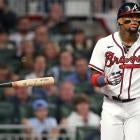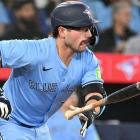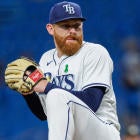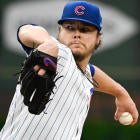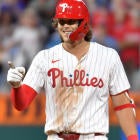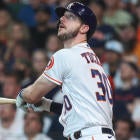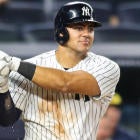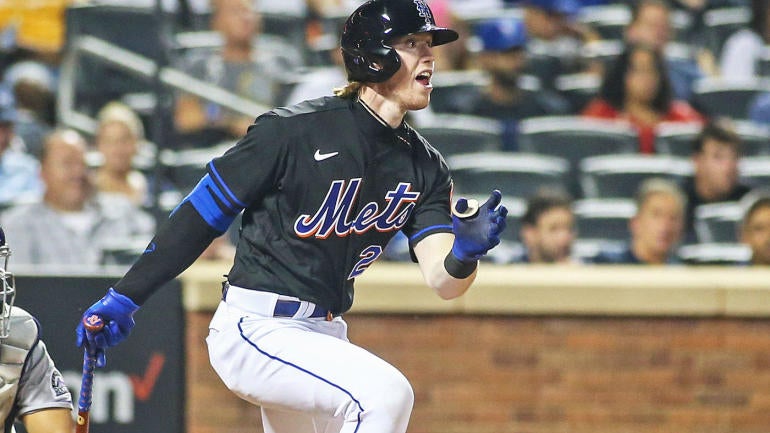
While we're catching our collective breath from the end of the first half of the season, the next generation of MLB stars are getting ready to take our breath away. We're probably at least three years away from the MLB Draft prospects mattering for most Fantasy players, but this year's class does feature a bunch of high-profile guys you saw if you followed college baseball this season.
Names like Paul Skenes and Dylan Crews from LSU, Wyatt Langford from Florida, and Rhett Lowder from Wake Forest could all make an impact in the majors sooner than most MLB Draft picks thanks to their dominance of the college ranks, so you want to know about them (and they aren't alone). That is why you need to make sure you check out Sunday's episode of Fantasy Baseball Today, as Frank Stampfl and Chris Welsh broke down the first round of the draft, with Welsh giving his first-year player draft rankings for the class.
The rest of today's FBT Newsletter is a bit more immediate. We're looking for sleepers to target for the second half, focusing mostly on players rostered in 60% of CBS Fantasy leagues or fewer. Like those MLB Draft prospects, none of these guys are sure things to make an impact right away, but all have the potential to help carry you to a championship down the stretch.
We'll start with some picks from Scott White and Frank Stampfl, and then me (Chris Towers, filling in for Dan Schneier this week) will give you 10 more candidates who could be surprisingly important for the second half of the Fantasy season:
Scott's second-half sleepers
Jonathan Aranda, 2B, Rays – The only problem with Aranda as a sleeper is the organization he's in. The Rays are perfectly fine leaving prospects in the minors way longer than most teams, and they'll call guys up only to have them sit five times in seven days. That said, Aranda is hitting .342/.455/.589 and was called up and started two games this weekend, so hopefully that means he's here to stay.
Nick Lodolo, SP, Reds – Lodolo is the perfect post-hype sleeper. He struggled to the tune of a 6.29 ERA in seven starts before an injury, but he's working his way back now, and still has huge potential for the stretch run – remember, he had a 2.75 ERA with 67 strikeouts in 55.2 innings over his final nine starts last season.
Dane Myers, OF, Marlins – Myers doesn't look like much of a prospect at first glance, seeing as he's already 27. However, he didn't transition to hitting until he was 25, and all he's done since then is produce, including a .994 OPS in Triple-A. He's playing everyday for the Marlins and has a bit of pop and speed, with 41 homers and 37 steals in 217 games between Double-A and Triple-A.
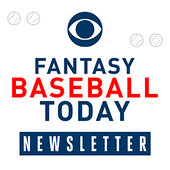
Fantasy Baseball Today Newsletter
Your Cheat Code To Fantasy Baseball
You're destined to gain an edge over your friends with advice from the award-winning FBT crew.
Thanks for signing up!
Keep an eye on your inbox.
Sorry!
There was an error processing your subscription.
Frank's second-half sleepers
Spencer Torkelson, 1B, Tigers – Torkelson is starting to produce, and the underlying numbers suggest he's been a lot better than his overall production. There are certainly still flaws in his game, but Torkelson is in the 92nd percentile in exit velocity this season while hitting a lot more line drives, so he could go on a big second-half run.
CJ Abrams, SS, Nationals – Abrams is on pace for one of the quieter 15-homer, 25-steal seasons in recent memory, and it could be a case of a young, talented player finally starting to figure things out. The Nationals recently moved him into the leadoff spot, and he's hit .367 in July with five steals in eight games. I like what we're starting to see.
Kenta Maeda, SP, Twins – I had pretty much written Maeda off after his miserable start to the season, but he's been much better since coming back from the IL, with 21 strikeouts to just five walks in 17 innings over three starts.
Chris' second-half sleepers
Bo Naylor, C, Guardians – Young catchers are notoriously poor bets, and Naylor hasn't shown us much yet in his time in the majors. Still, anyone in a two-catcher league almost certainly needs help at the position, and this is a top prospect who has hit .255/.379/.507 with 11 steals and 28 homers in 126 games since getting to Triple-A. I'd much rather place a bet on Naylor living up to his potential than settle for a boring, low-upside option like Elias Diaz or Yan Gomes.
Triston Casas, 1B, Red Sox – Casas hasn't been playing every day of late, but I'm optimistic that he can force the Red Sox's hands. He got off to a miserable start, but hit .286/.375/.476 in June, a lot more like what we were hoping to see from him. The quality-of-contact metrics mostly suggest Casas has been better than his actual production, with an average exit velocity in the 83rd percentile and a barrel rate in the 82nd percentile. There's still a bit too much swing-and-miss here to expect much from Casas in batting average, but I think a second-half power breakout is a perfectly reasonable expectation.
Brett Baty, 3B, Mets – A lot of what I said about Casas applies to Baty, who has failed to take the league by storm as we might have hoped. Unlike Casas, Baty is having trouble tapping into his power in games mostly because he just doesn't elevate the ball very much – it's hard to hit for power when 52% of your batted balls are on the ground. However, that's an aspect of Baty's game he showed the ability to improve on in the minors, and the raw power here is still impressive. Like Casas, it's a bet on a young guy improving one key aspect of his game to unlock another level.
Zachary Neto, SS, Angels – Neto's injury came at such a tough time, because it looked like he was starting to figure things out at the MLB level. In the 12 June games he played before his oblique injury, Neto was hitting .355/.444/.710, with just six strikeouts in 37 trips to the plate. His .337 wOBA was solid, but his .348 xwOBA was even better, and Neto was already on close to a 20-homer, 20-steal pace before the injury. Could he do a 25-25 pace in the second half?
Christian Encarnacion-Strand, 3B, Reds – From a performance standpoint, there isn't much Encarnacion-Strand seems to have left to prove at Triple-A. He's hitting .321/.392/.620 with improving plate discipline as the season has gone on, all while learning to play the outfield for the first time. The Reds already have too many players for their everyday lineup, but Encarnacion-Strand still looks like a potential difference maker if he gets the opportunity.
Oscar Colas, OF, White Sox – Colas hasn't done much in the majors so far, but I'm still not giving up on the potential here. He hit .293/.359/.508 in Triple-A before being recalled last week, after all. It's been a disappointing season for a guy who came in with a lot of hype, but sometimes it takes guys a bit of time to figure things out, especially relatively free swingers like Colas. But when he locks in, he could be dangerous.
Sal Frelick, OF, Brewers – If it weren't for injuries and underperformance, Frelick probably would have already gotten the call, but he's hitting just .237 so far this season. Still, his plate discipline has been terrific, and while there may not be a ton of pop in his bat, Frelick could be a legitimate plus in batting average and speed if he gets right.
Edward Cabrera, SP, Marlins – Cabrera's shoulder injury came at a tough time for the Marlins, as it complicated their plans to manage Eury Perez's innings. It also came at a tough time for Cabrera, who looked like he was really starting to figure things out – in seven games before the injury, he had cut his walk rate to a manageable 8.9%, with a strikeout rate of 30.1%. Cabrera could be back in the rotation after the break, and could be a big second-half breakout candidate.
Brandon Pfaadt, SP, Diamondbacks – The Fantasy community was hyping Pfaadt way too much at the beginning of the season, discussing him as if he was an ace in the making despite serious struggles keeping the ball in the yard in the minors. He's flopped hard so far, but sometimes it just takes guys some time to figure out how to get major-leaguers out. I'll give Pfaadt another shot when the Diamondbacks do.
Christopher Sanchez, SP, Phillies – Sanchez probably doesn't have the same kind of upside as Cabrera or Pfaadt, but I find him kind of interesting in his own right. He's never really put up great numbers throughout the minors, mostly because he struggled with control, something that followed him to the majors last season. But that hasn't been an issue so far this season, with just four walks in 25.1 innings. He's a ground-ball pitcher who doesn't get a ton of strikeouts, but if he can keep the walks down while striking out batters at around an average pace as he has so far, he could be pretty useful. The leap his changeup has seemingly made – to a 42% whiff rate and .129 expected wOBA allowed so far – certainly helps.














